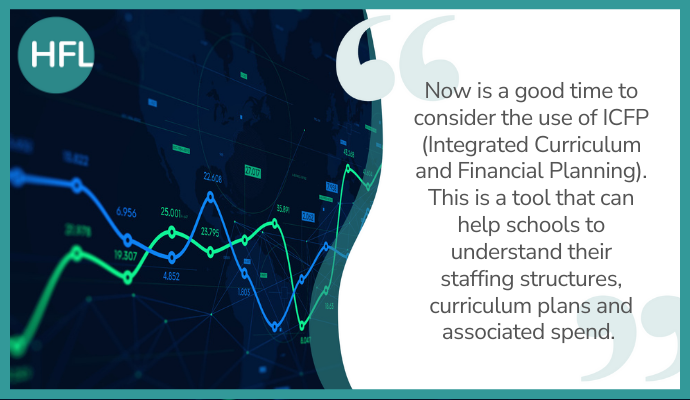
As we are all aware, the cost-of-living crisis is having a severe and significant impact on schools and academies across the country. Fuel costs have become unpredictable, the rise in food prices is impacting on our breakfast and afterschool clubs, and the unfunded teachers pay award is untenable for most settings. Those are just a few of the cost pressures that schools are dealing with, and many are finding that their revenue income just doesn’t cover all their expenses.
With staffing costs constituting at least 70% of every school spend and increasing (we regularly see it as high as 86- 90%), now is a good time to consider the use of ICFP (Integrated Curriculum and Financial Planning). This is a tool that can help schools to understand their staffing structures, curriculum plans and associated spend. Whilst it is still important to look at ways to reduce non staff costs, it is equally important for schools and trusts to be looking at the efficient deployment of all staff. ICFP is not about making redundancies, but ensuring staff are fully deployed in an effective way, supporting the best outcomes for pupils.
It sounds more frightening that it is. It’s not complicated, it’s just using easily available data (such as nominal role, school census, ABR) to analyse your expenditure on curriculum. It has been used in secondary schools for a number of years, but it is also relevant to primary schools and can help the school design an affordable relevant curriculum and utilise staffing in the most efficient way.
There are a number of different metrics that can be used to analyse and understand your data, available from the DfE, ISBL ACSL…. all have slightly different calculations. There is no right or wrong – it is about understanding what has gone into the calculation, how you reach your results and what you do with that information. The data will be specific to your school and must always be used within local context. There is no right or wrong answer, but the data should be able to provoke discussion and to enable schools and trusts to better understand how spend is being directed.
Some of the key metrics, amongst others, will show you:
- the cost of employing a teacher – average teacher cost
- the amount of time a teacher is teaching – teacher contact ratio
- average class size
- pupil teacher ratio
- leadership costs
Key questions that schools and trusts should be asking are:
- why are out staffing costs different from the national data?
- why are our class sizes different? If a school has smaller class sizes, what is the cost implication versus the impact on pupil outcomes?
- are we happy with the structure that we have?
- can we move to a new more cost-effective structure?
- immediately – think about the repercussions, the impact on staff welfare and workload
- next year?
- or work towards it in the future 3–5-year staffing and financial plans are extremely important.
Remember, this is not just for schools in financial difficulty – it is about the best use and deployment of staff to enable schools to plan and deliver the curriculum they need to meet pupil needs, it is about sustainability – thinking ahead and planning for the future.
For further information on ICFP, please visit the DFE website at:






